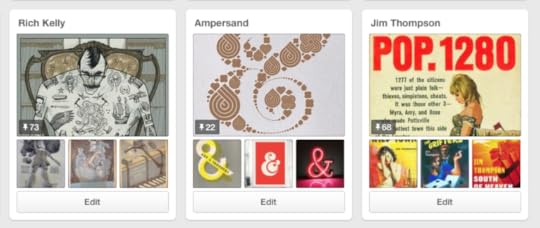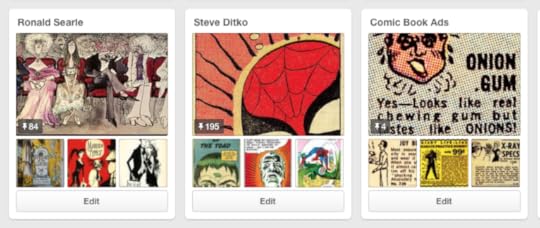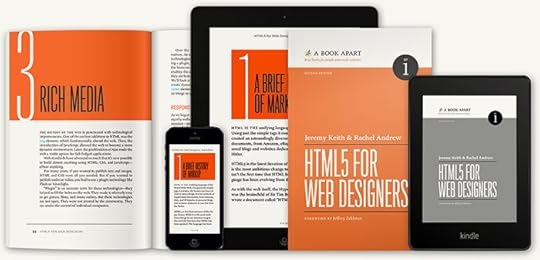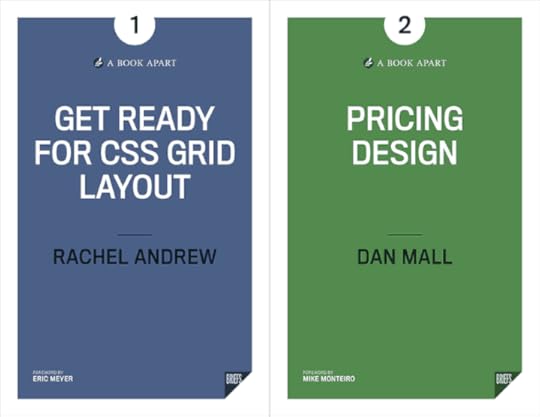Jeffrey Zeldman's Blog, page 24
March 18, 2016
Pinterest giveth, and Pinterest taketh away

AS MY design career has taken on more and more strategic and managerial freight, I’ve done less and less hands-on design. This year, I decided to change that. As part of my reimmersion, I found myself reading less, and absorbing visual information more. Enter Pinterest.
I’d played with the app when it first came out—who didn’t?—but it didn’t stick with me the way a handful of apps do. It didn’t become an obsession, and so I gradually forgot about it. That’s just how apps work for me. They’re heroin, or they’re nothing.
But the moment my days began filling with sketching, and coding, and Photoshop comping, the genius of Pinterest, and the addictive high it provides when used obsessively and compulsively, was revealed to me.
In borderline religious ecstasy, I became a Pinterest junkie, compelled to collect and catalog every artist I’ve ever loved—every type designer, illustrator, filmmaker, social absurdity, comic book character, and book designer; every half-forgotten cartoonist; every city or nation I’ve visited.
Using Pinterest not only revived long-dead visual design brain cells, it created new ones. Work-related layouts and color schemes came easier as I spent more and more “downtime” collecting and cataloging half-forgotten styles, genres, and artists—and discovering new ones.
I ♥ Pinterest
As part of this work—for work it is; call it “research” if you prefer—I spent hours rearranging Boards on my profile for maximum aesthetic effect and rhythm. And more hours choosing and replacing the cover illustration for each Board. (If you don’t use Pinterest, here’s a summary: it lets you pin any image you find on the web, or on your own computer desktop or mobile device, to a virtual whiteboard. Pinterest calls each whiteboard you create a “Board,” and each image you affix to it a “Pin.” Part of the fun comes from sequencing Boards on your profile for aesthetic or educational reasons; choosing the featured image for each Board is likewise important and fun.)
Until a few days ago, you could edit and re-edit the featured image for each Board whether you were using Pinterest on the web (that is, via desktop computer), your phone, or your tablet. Doing these things worked differently on the different devices—choosing the featured image was actually faster and less tedious on iPhone and iPad than it was on the web—but the functionality was available in all three places, because Pinterest recognized that brands exist between devices, and that folks interact with your service on different devices at different times, as they choose.
Likewise, until a few days ago, you could change the order of Boards on your profile via drag and drop whether you were using Pinterest on the web or your tablet. (Likely because of screen space constraints, this functionality was not available on iPhone, where the display of Board content necessarily differs from the more desktop-design-focused method used on the web and on iPad.) Users like me changed the order of Boards to create visual interest, set up ironic contrasts, create visual rhythms up and down the screen, and so on. I’m a designer. I have my ways. These details are important to me—and, I imagine, to many other users, since Pinterest is a drug for visual obsessives.
An unexpected change
Then, a few days ago, Pinterest released an update that removed this functionality from the iPhone and iPad (and, I’m assuming, from Android as well). There was no blog post announcing the change. And no rationale offered for taking away features that mattered a lot to users like me. Pinterest knows these features matter, because Pinterest has our data. That’s the difference between making a digital product folks interact with via the internet, and making, say, a toilet plunger. If I manufacture toilet plungers, I can make assumptions about how folks use my product, but I probably don’t have much real data. If I make an application people use via http, I know everything.
Now, it’s not like people were complaining about the ability to edit their Boards: “We have too much freedom! This software provides too many delightful functions. Please remove two of them. But only from my mobile device.”
No. The features are still there on the website. So Pinterest knows people like these features.
And it’s not like the features are too difficult to put into mobile devices, since they already existed in those mobile devices.
A failure to communicate
You may ask why I’m telling you all this instead of telling it to Pinterest. Good question. The answer is, I tried telling Pinterest, but they don’t provide a forum for it. And that is the biggest problem. A company that makes products people love should have a way to communicate with those people. Not grudgingly offer them a few character-limited form fields on a “survey” page that isn’t even referenced in the site’s navigation.
When the features stopped working on my iPhone and iPad, I assumed something had gone wrong with my apps, so I deleted and reinstalled them. (Remember, there was no announcement; but then why would any company announce that it was taking away loved features for no apparent reason?)
When deleting and reinstalling didn’t help, I sought help and contact pages on Pinterest (and was only able to find them via third-party search engine).
In trying to file a bug report, I ended up in a pleasant (but confusing) conversation with a very nice Pinterest employee who explained that I wasn’t experiencing a bug: the software engineers had made a conscious decision to remove the functions I use every day … and had no intention of restoring them. She wasn’t able to tell me why, or point me to a URL that would offer a rationale, but she did tell me I could use Pinterest’s “Recommend a feature” form to “recommend” that the software engineers put those features back.
Since “Recommend a feature” is hidden from site navigation, the kindly person with whom I was in dialog provided a link where I could type in a few characters requesting that Pinterest restore the “drag Board order” functionality. There wasn’t room in the form fields to explain why I thought the feature should be restored, but at least I was able to make the request. The form asked if I was a Business account user, which I am. I don’t remember when or why I bought the Business tier of service. Maybe for the analytics. Maybe just because, as someone who makes stuff myself, I choose to pay for software so I can support the good people who make it, and do what I can to help their product stick around.
(It’s the same reason I remained a Flickr Pro user even after Yahoo gave the whole world 2GB of photo storage space for free. If everything is free, and nobody pays, services you love tend to go away. Half of web history is great services disappearing in the night after investors were dissatisfied with only reasonable profits.)
I don’t know why my paid status mattered to Pinterest, but I couldn’t help feeling there would be a prejudice in favor of my comment if I checked the box letting them know I was a paying customer. Even though it was information they requested, checking the box made me feel dirty. I also wondered why they were asking me. I mean, don’t they know? I gave them the email address they use for my login. I was logged in. They know my status. Are they just checking to see if I know it, too?
There can only be one (feature request)
But I digress. Because here is the main point. The moment I submitted the tiny, inadequate form requesting the restoration of a recently removed feature, the site set a cookie and sent me a message thanking me for completing the “survey.” It wasn’t a survey, but I guess one task completion message is as good as another.
Then I tried to use the inadequate form to report my second concern—the one about the removal of the ability to choose a featured image for my Board. The way this had always worked on the tablet was far superior to the tedious, painstaking way it works on my desktop. On the tablet, you could scroll through all your images with the flick of a finger, select the image you wanted, and complete the task in a few seconds. On the desktop, you had to click your way through every image on your Board in reverse chronological order. It’s the difference between flicking through a calendar, and clicking backwards from today, to yesterday, to the day before yesterday, and so on. The tablet version was fast, easy, intuitive—you interact directly with your content; you can see all relevant content at a glance. The desktop version is cumbersome and 1999-ish. If I had to pick which platform must lose the functionality I relied on, I would not have chosen the tablet. No customer who used the feature in both places would.
But I wasn’t able to share even a few characters of this thought with Pinterest, because once you submit a “survey” requesting a feature, a steel wall in the guise of a cookie slams down, and you cannot make a second feature suggestion.
Not even the next day. (Which is today. Which I just tried.)
This is a love letter
And that is why, as a hardcore fan and user of Pinterest, a service I love and use compulsively, I am using the public web rather than Pinterest’s somewhat unhelpful help center, to share my request with the brilliant software engineers who create this fabulous product.
And with designers, because these are the mistakes we all make when we create products and content sites. We think we are all about the people who use what we create. But we are probably frustrating the pants off them with our arbitrary design decisions and inadequate customer feedback mechanisms.
The post Pinterest giveth, and Pinterest taketh away appeared first on Zeldman on Web & Interaction Design.
March 17, 2016
Grid Layout & Flexbox City

CSS GRID LAYOUT is nearly finalized. Which means it’s time for designers and front-end developers to set the flags enabling their browsers to support the new specification, put CSS Flexbox through its paces by using it to create layouts, and see if anything breaks. This way, if anything does break, we’ll have time to tell the framers of CSS Grid Layout what happened, and get the spec (and browser support) fixed before it is released. Once Grid is finalized, it will be too late to fix oversights.
The links below can help you (and me) get up to speed with the new tech:
CSS Grid Layout and CSS Flexbox Links
CSS Grid Spec
How to enable CSS Grid Layout in your browser
Grid By Example: Learn CSS Grid Layout by doing, with these incredibly useful examples by Rachel Andrew. Newly updated. Fun!
A Complete Guide to Grid by Chris Coyier
A Complete Guide to Flexbox by Chris Coyier
Though CSS Flexbox is better suited to laying out modules (rather than entire pages—that’s what Grid is for), Phillip Walton has used it to solve a classic CSS page layout problem: Holy Grail layout in Flexbox
Vertical centering? Easy. Equal height columns? By default. Paul Robert Lloyd gets to grips with CSS Flexbox and finds a lot to like: CSS Flexbox Is Entirely Logical (Almost)
Three Years with CSS Grid Layout by Rachel Andrew
Grid, Flexbox, Box Alignment: Our New System for Layout by Rachel Andrew
CSS Grid Layout Examples: Several examples showing different CSS Grid Layout use cases
CSS Grid and the Box Alignment Module
Thank You
Additional link curation by Rachel Andrew, author of Get Ready for CSS Grid Layout from A Book Apart, and speaker extraordinaire at An Event Apart Nashville, a three-day conference that wrapped yesterday. For a ton of great web resources, see AEA Resources: Articles, Links, and Tools From An Event Apart Nashville 2016.
The post Grid Layout & Flexbox City appeared first on Zeldman on Web & Interaction Design.
February 24, 2016
Helvetica With Curves—And Other Updated Classics

Title card from ‘Designing With Web Standards in 2016,’ An Event Apart presentation by Jeffrey Zeldman. Text is set in Forma, an upcoming face from Font Bureau.
NOT UNLIKE what Mattel has done with Barbie, the typographic geniuses at The Font Bureau are working on a humanist geometric sans-serif that could almost be thought of as Helvetica with curves.
Forma is the name of the as-yet unreleased font family, and you can get a peek at one weight of it in the above image, which is taken from my slide deck for “Designing With Web Standards in 2016,” which is the presentation I’ll premiere next month at An Event Apart Nashville.
This new presentation examines the seemingly ever-deepening complexity of designing for our medium today—a complexity that has driven some longtime web designers I know to declare that web design has become “too hard,” or that “the fun has gone out of it”—and asks what our traditions of designing with web standards can teach us about crafting web experiences for a multi-device, mobile-first world.
Given that my original (unpublished) title for Designing With Web Standards was going to be Forward Compatibility—and given that Forward Compatibility is not so different in concept from today’s phrase, Future-Friendly—I’m guessing that structured, semantically marked-up content, progressive enhancement, and the separation of style from structure and behavior still have a huge role to play in today’s day-to-day web design work.
Oh, dear, I hope that wasn’t a spoiler.
I look forward to sharing these ideas with you in greater detail at An Event Apart. Now celebrating our tenth year of bringing great ideas to our community, and creating a space where the smartest folks in web design and development can meet, mingle, bond, network, and learn together. Follow @aneventapart for show announcements, links to useful web resources, and free giveaways on the 10th of every month in 2016. (This month’s giveaway, ten beautiful fleece comforters monogrammed with the A Decade Apart logo, went to ten lucky winners on February 10th. Keep watching the skies.)
The post Helvetica With Curves—And Other Updated Classics appeared first on Zeldman on Web & Interaction Design.
February 18, 2016
Foreword to HTML5 for Web Designers, 2nd Edition
WELCOME to the second edition of HTML5 for Web Designers, the book that launched a thousand sites—or apps, if you prefer. It is also the book whose first edition launched our little craft publishing house. And its new edition comes to you when it is needed most, on a web riven by conflicting visions.
For some folks, the web today is what it has always been: namely, the most accessible medium ever devised for sharing content. For others, including the heads of powerful tech companies, the web is a platform for building JavaScript-powered applications whose purpose is to disrupt every industry on earth, chiefly for the benefit of investors.
Adherents of both camps are equally passionate—and both swear by HTML5, which was designed to create both kinds of web. HTML5 has given us a web both more powerful and more divided.
So much has changed over the past five years, it’s hard to remember that many businesses were still betting on Flash as recently as 2009, and still building sites and applications exclusively for the desktop browser. Then, in 2010, Steve Jobs famously declared that his iPhone would not support Flash. Flash was dead, Steve said. HTML5 was the future. A hundred thousand designers, developers, and site owners suddenly asked themselves, “HTML wha—?” The next day, our little book came out, which was good timing for sales, but even better for the industry. And there are still no better guides to the new markup language than Jeremy Keith and Rachel Andrew.
In this book, you will learn what HTML5 is, why it came to be, and how to use it to create sites and applications as powerful as anything you can imagine. Forms, elements, semantics, scripting? It’s all here, guided by a set of principles as straightforward as they are noble—principles that deliver sophisticated web interactivity while remaining true to Tim Berners-Lee’s twenty-five-year-old vision of an open, accessible web that works for all. This book spells out a philosophy that will deepen not only the usability of your projects, but their humanism as well.
HTML5 for Web Designers is a book about HTML like Elements of Style is a book about commas. It’s a book founded on solid design principles, and forged at the cutting edge of twenty-first century multidevice design and development. Jeremy Keith and Rachel Andrew never, for one second, forget what moment of web design history we are in, and how much depends upon our ever bearing in mind not only our users in the wealthiest countries, but also the least of these. I know, admire, and continually learn from the depths of the authors’ belief in humanity and HTML. You will, too.
 Jeffrey Zeldman
Jeffrey Zeldman
Publisher
A Book Apart
February 17, 2016
The post Foreword to HTML5 for Web Designers, 2nd Edition appeared first on Zeldman on Web & Interaction Design.
January 21, 2016
Big Web Show № 142: Information Architecture is Still Very Much a Thing, with Abby Covert
 Today’s Big Web Show guest is Abby Covert, Information Architect; curator of IA Summit; co-founder of World IA Day; president of IA Institute; teacher in the Products of Design MFA program at New York’s School of Visual Arts; and author of How To Make Sense of Any Mess, a “brilliant introduction to information architecture” (Peter Morville) that is frequently purchased at Amazon with Don’t Make Me Think and The Design of Everyday Things, the two classics of usable design.
Today’s Big Web Show guest is Abby Covert, Information Architect; curator of IA Summit; co-founder of World IA Day; president of IA Institute; teacher in the Products of Design MFA program at New York’s School of Visual Arts; and author of How To Make Sense of Any Mess, a “brilliant introduction to information architecture” (Peter Morville) that is frequently purchased at Amazon with Don’t Make Me Think and The Design of Everyday Things, the two classics of usable design.
Discussed: why IA matters now more than ever, the difference between IA and content strategy (IA is building the vehicle, CS is putting fueling it and making sure it won’t run out of gas), writing and designing a book, building agreement among stakeholders, “not having opinions, not having ideas of one’s own,” IA’s origins in language and structure, the fun of the IA Summit, the creation and growth of World IA Day, the joy of teaching, and more.
Enjoy Episode № 142 of The Big Web Show: Information Architecture is Still Very Much a Thing, with Abby Covert.
URLs
http://abbytheia.com
https://twitter.com/abby_the_ia
https://twitter.com/IAinstitute
http://worldiaday.org
https://twitter.com/SVAPOD
http://www.howtomakesenseofanymess.com
http://www.amazon.com/How-Make-Sense-Any-Mess/dp/1500615994/
http://www.merriam-webster.com/dictionary/retronym
Sponsored by A List Apart
The award winning Big Web Show features special guests and topics like web publishing, art direction, content strategy, typography, web technology, and more. It’s everything web that matters.
The post Big Web Show № 142: Information Architecture is Still Very Much a Thing, with Abby Covert appeared first on Zeldman on Web & Interaction Design.
Sharing is Caring: the Shopify Partner Studio Program
THE INTERNET, as we all know, makes it possible to work from anywhere. Back in 1999, I started Happy Cog studio from a desk in my bedroom. I shouldn’t even call it a desk. It was a door on top of two filing cabinets. But that, a Mac, and an internet connection were enough to launch my web design business.
But creative people thrive by rubbing shoulders with other creative people, which is why I opened a studio as soon as the business I was doing justified the expense.
It’s no secret that coworking spaces have exploded in the past five to ten years, and the communal setting they offer helps freelancers, remote workers, and other independent professionals work better and more happily. But, as good as coworking spaces are, I believe designers and developers do even better in a shared studio where the same talented folks come in day after day, sitting at the same desks every day. That’s why I opened A Space Apart in 2012, and it’s why I’m delighted to open my studio to the Shopify Partner Studio Program.
If you’re a qualifying designer or developer just starting your career, we want you here. Besides rubbing shoulders with each other, and with some of the smartest designers and developers I know, you’ll gain mentorship experience from Shopify execs, web design/development industry icons, and me. (Never fear, I’ll learn more from you than you will from me.)
So kickstart your freelance business with free office space and mentorship from Shopify and me. If you haven’t already done so, apply now!
The post Sharing is Caring: the Shopify Partner Studio Program appeared first on Zeldman on Web & Interaction Design.
January 11, 2016
CSS Grid Layout with Rachel Andrew: Big Web Show
RACHEL ANDREW—longtime web developer and web standards champion, co-founder of the Perch CMS, and author of Get Ready For CSS Grid Layout—is my guest on today’s Big Web Show. We discuss working with CSS Grid Layout, how Grid enables designers to “do something different” with web layout, why designers need to start experimenting with Grid Layout now, how front-end design has morphed into an engineering discipline, learning HTML and CSS versus learning frameworks, and the magic of David Bowie, RIP.
Enjoy Episode № 141 of The Big Web Show.
Subscribe via iTunes.
Subscribe via RSS
Sponsored by A List Apart and An Event Apart.
URLs
rachelandrew.co.uk
Get Ready for CSS Grid Layout
Perch CMS
Writing by Rachel Andrew
Books by Rachel Andrew
@rachelandrew
The post CSS Grid Layout with Rachel Andrew: Big Web Show appeared first on Zeldman on Web & Interaction Design.
January 7, 2016
A Book Apart Briefs!
FROM THOSE WONDERFUL people who brought you Responsive Web Design, Design Is A Job, Mobile First, plus thirteen additional instant classics of web design and development, here come A Book Apart Briefs: even briefer books for people who make websites. Starting with the immediately useful and illuminating Get Ready For CSS Grid Layout by Rachel Andrew (foreword by Eric Meyer), and Pricing Design by Dan Mall (foreword by Mike Monteiro).
Web design is about multi-disciplinary mastery and laser focus, so we created A Book Apart to cover the emerging and essential topics in web design and development with style, clarity, and, above all, brevity. Every title in our catalog sheds clear light on a tricky subject, and fast, so you can get back to work.
With sixteen classics under our belt, and buoyed by your support over the years, today we take that mission one step further with our new, ebook-only guides to essential fundamentals, of-the-moment techniques, and deep nerdery.
As A Book Apart co-founder and publisher, it actually thrills me to bring you the pricing guide our business has needed since forever, by Superfriends founder Dan Mall; and the easily understandable guide to the next generation of CSS layout, by the super-talented and incredibly brilliant Perch co-founder Rachel Andrew.
There are no better writer/designers to present these topics. And there are no needless words to waste your time, because these are A Book Apart Briefs: same great writing, even more brief.
Dig in!
The post A Book Apart Briefs! appeared first on Zeldman on Web & Interaction Design.
January 5, 2016
Of Patterns and Power: Web Standards Then & Now

IN “CONTENT Display Patterns” (which all front-end folk should read), Dan Mall points to a truth not unlike the one Ethan Marcotte shared last month on 24 ways. It is a truth as old as standards-based design: Construct your markup to properly support your content (not your design).
Modular/atomic design doesn’t change this truth, it just reinforces its wisdom. Flexbox and grid layout don’t change this truth, they just make it easier to do it better. HTML5 doesn’t change this truth, it just reminds us that the separation of structure from style came into existence for a reason. A reason that hasn’t changed. A reason that cannot change, because it is the core truth of the web, and is inextricably bound up with the promise of this medium.
Separating structure from style and behavior was the web standards movement’s prime revelation, and each generation of web designers discovers it anew. This separation is what makes our content as backward-compatible as it is forward-compatible (or “future-friendly,” if you prefer). It’s the key to re-use. The key to accessibility. The key to the new kinds of CMS systems we’re just beginning to dream up. It’s what makes our content as accessible to an ancient device as it will be to an unimagined future one.
Every time a leader in our field discovers, as if for the first time, the genius of this separation between style, presentation, and behavior, she is validating the brilliance of web forbears like Tim Berners-Lee, Håkon Wium Lie, and Bert Bos.
Every time a Dan or an Ethan (or a Sara or a Lea) writes a beautiful and insightful article like the two cited above, they are telling new web designers, and reminding experienced ones, that this separation of powers matters.
And they are plunging a stake into the increasingly slippery ground beneath us.
Why is it slippery? Because too many developers and designers in our amnesiac community have begun to believe and share bad ideas—ideas, like CSS isn’t needed, HTML isn’t needed, progressive enhancement is old-fashioned and unnecessary, and so on. Ideas that, if followed, will turn the web back what it was becoming in the late 1990s: a wasteland of walled gardens that said no to more people than they welcomed. Let that never be so. We have the power.
As Maimonides, were he alive today, would tell us: he who excludes a single user destroys a universe. Web standards now and forever.
The post Of Patterns and Power: Web Standards Then & Now appeared first on Zeldman on Web & Interaction Design.
CSS & Design: Blending Modes Demystified
IN AN IDEAL world, we’d be able to modify a design or graphic for the web while keeping the original intact, all without opening an image editor. We’d save tons of time by not having to manually reprocess graphics whenever we changed stuff. Graphics could be neatly specified, maintained, and manipulated with just a few licks of CSS. Oh. Wait. We can do that! Justin McDowell gives us the lowdown: read Blending Modes Demystified in today’s A List Apart.
Illustration by Brad Colbow
The post CSS & Design: Blending Modes Demystified appeared first on Zeldman on Web & Interaction Design.













